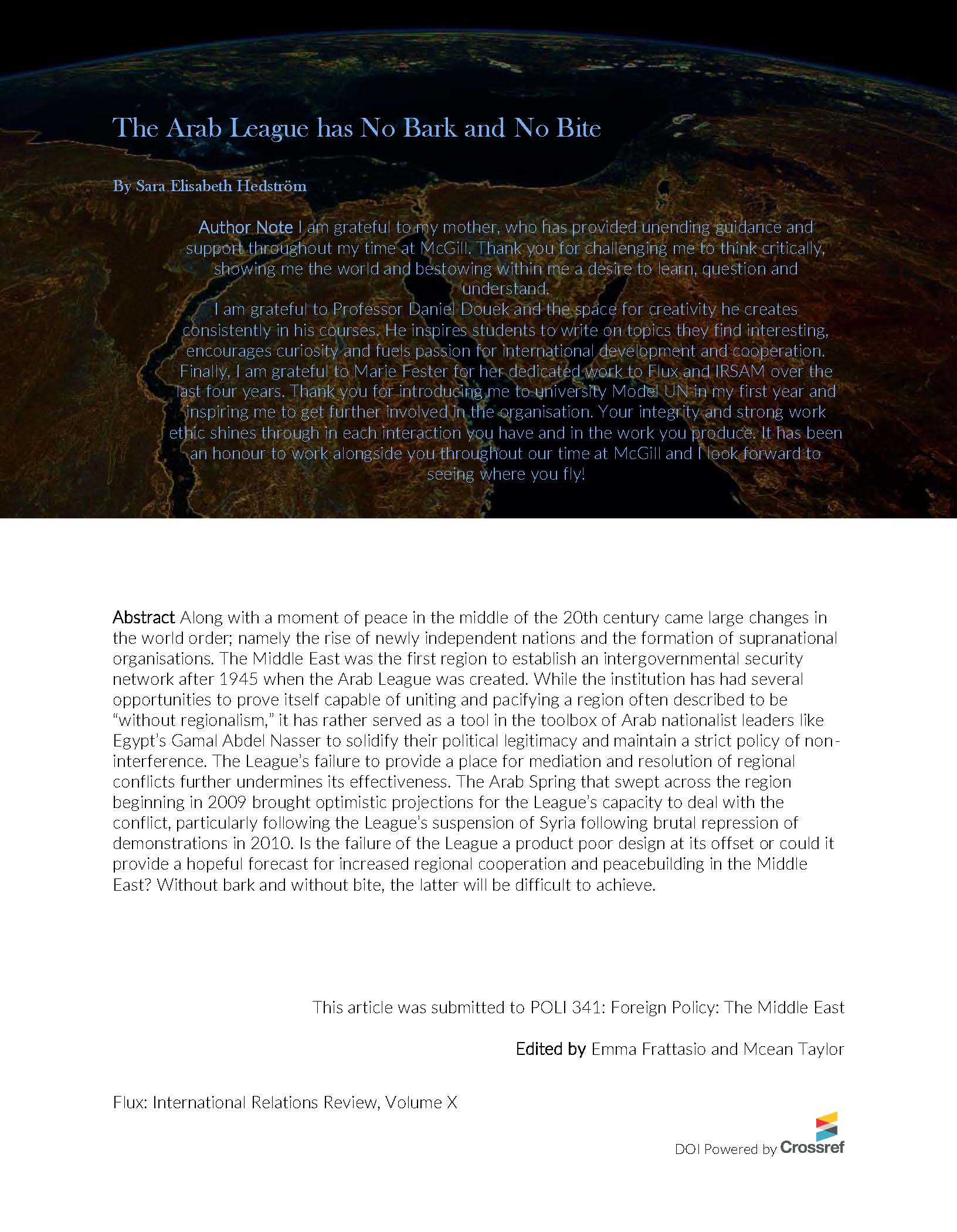The Arab League has No Bark and No Bite
DOI:
https://doi.org/10.26443/firr.v10i1.28Abstract
Abstract Along with a moment of peace in the middle of the 20th century came large changes in the world order; namely the rise of newly independent nations and the formation of supranational organisations. The Middle East was the first region to establish an intergovernmental security network after 1945 when the Arab League was created. While the institution has had several opportunities to prove itself capable of uniting and pacifying a region often described to be “without regionalism,” it has rather served as a tool in the toolbox of Arab nationalist leaders like Egypt’s Gamal Abdel Nasser to solidify their political legitimacy and maintain a strict policy of non-interference. The League’s failure to provide a place for mediation and resolution of regional conflicts further undermines its effectiveness. The Arab Spring that swept across the region beginning in 2009 brought optimistic projections for the League’s capacity to deal with the conflict, particularly following the League’s suspension of Syria following brutal repression of demonstrations in 2010. Is the failure of the League a product poor design at its offset or could it provide a hopeful forecast for increased regional cooperation and peacebuilding in the Middle East? Without bark and without bite, the latter will be difficult to achieve.
Downloads
References
Aarts, P. 1999. “The Middle East: A Region without Regionalism or the End of Exceptionalism?” Third World Quarterly 20, no. 5: 911–925. https://doi.org/10.1080/01436599913406
Barnett, Michael and Etel Solingen. 2007. “Designed to Fail or Failure of Design? The Sources and Institutional Effects of the Arab League.” In Crafting Cooperation: Regional Institutions in Comparative Perspective, edited by A. Acharya and A. Iain. New York: Cambridge University Press, 180-220. https://doi.org/10.1017/CBO9780511491436.
Beck, Martin. 2014. “The Concept of Regional Power as Applied to the Middle East.” In Regional Powers in the Middle East, The Modern Muslim World, edited by Henner Fürtig. New York: Palgrave Macmillan, 1-20. https://www.palgrave.com/gp/book/9781137484741.
Beck, Martin. 2015. “The End of Regional Middle Eastern Exceptionalism? The Arab League and the Gulf Cooperation Council after the Arab Uprisings.” Democracy and Security 11, no. 2: 190-207. DOI:10.1080/17419166.2015.1037390.
Borger, Julien. 2012. “Draft resolution to UN calls for Syria’s Assad to step down.” The Guardian. January 31. https://www.theguardian.com/world/2012/jan/31/un-resolution-syria-assad-step-down.
Bremmer, Ian. 2018 “Why the Syrian Civil War Is Becoming Even More Complex.” Time. April 9. http://time.com/5229691/syria-trump-putin-saudi-arabia/.
Dakhlallah, Farah. 2012. “The League of Arab States and Regional Security: Towards an Arab Security Community?” British Journal of Middle Eastern Studies 39, no. 3: 393-412, DOI:10.1080/13530194.2012.726489.
Fawcett, Louise. 2004. “Exploring Regional Domains: A Comparative History of Regionalism.” Royal Institute of International Affairs 1944-present 80, no. 3: 429-446. https://www.jstor.org/stable/3569018.
Harb, Imad K. 2017. “The Difficult Tasks for the Arab League.” The Arab Center Washington DC. 22 March. http://arabcenterdc.org/policy_analyses/task-for-las/.
Hourani, Cecil. 1947. “The Arab League in Perspective.” Middle East Journal 1, no. 2: 129-141. https://www.jstor.org/stable/4321856.
Kechichian, Joseph. 1994. “Security Efforts in the Arab World: A Brief Examination of Four Regional Organizations.” Santa Monica, CA: RAND Corporation. https://www.rand.org/pubs/notes/N3570.html.
Korany, Bahgat. 2017. "The Middle East since the Cold War: The multi-layered (in)security Dilemma." In International Relations of the Middle East, edited by Louise Fawcett. Oxford: Oxford University Press, 94. https://www.oxfordpoliticstrove.com/view/10.1093/hepl/9780198708742.001.0001/hepl-9780198708742-chapter-4.
Lerman, Eran. 1995. “A Revolution Reconfigured: Foreign Policy Orientation in the Postwar Years.” In Egypt: From Monarchy to Republic, edited by Shimon Shamir. Boulder: Westview Press, 283-309.
Little, T. R. 1956. “The Arab League: A Reassessment.” Middle East Journal 10, no. 2: 138-150. https://www.jstor.org/stable/4322798.
Lustick, Ian. 1997. “The Absence of Middle Eastern Great Powers: Political "Backwardness" in Historical Perspective.” International Organization 51, no. 4: 653-83. DOI:10.1162/002081897550483.
Noble, Paul C. 1984. "The Arab State System: Opportunities, Constraints, and Pressures." In The Foreign Policies of Arab States, edited by B. Korany and A.E. Hillal Dessouki. Boulder: Westview Press, 41-77.
Nolte, Detlef. 2010. “How to Compare Regional Powers. Analytical Concepts and Research Topics.” Review of International Studies 36, no. 4: 881-901. https://doi.org/10.1017/S026021051000135X.
Pinfari, Marco. 2009. “Nothing but failure? The Arab League and the Gulf Cooperation Council as mediators in Middle Eastern conflicts.” Crisis States Research Centre, London School of Economics, March. http://www.lse.ac.uk/international-development/Assets/Documents/PDFs/csrc-working-papers-phase-two/wp45.2-nothing-but-failure.pdf.
Pinfari, Marco. 2016. “Regional Organizations in the Middle East.” Oxford Handbooks Online. DOI:10.1093/oxfordhb/9780199935307.013.86.
Rami, Khouri. 2011. “The Arab League awakening.” The Globe and the Mail. November 15. https://www.theglobeandmail.com/opinion/the-arab-league-awakening/article4251442/.
Waltz, K. N. 1979. Theory of international politics. Reading: Addison-Wesley Pub.

Downloads
Published
Issue
Section
License
Copyright (c) 2020 Elisabeth Hedstrom

This work is licensed under a Creative Commons Attribution-NonCommercial-NoDerivatives 4.0 International License.

